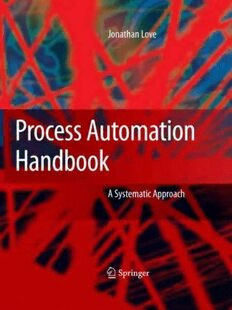Download Process Automation Handbook: A Guide to Theory and Practice PDF Free - Full Version
Download Process Automation Handbook: A Guide to Theory and Practice by Jonathan Love in PDF format completely FREE. No registration required, no payment needed. Get instant access to this valuable resource on PDFdrive.to!
About Process Automation Handbook: A Guide to Theory and Practice
To be effective as an engineer practicing in the field of process automation requires a breadth of knowledge across a wide range of disciplines: chemical engineering, instrumentation, electrical engineering, control theory, mathematics, computing and management. Previously published books exist in these areas but most are generic and, of those that are applied in nature, few are oriented towards the actual needs of the chemical and process industry. It is impractical for engineers and unreasonable for students to have to cope with this spectrum of material and lack of emphasis. The objective of Process Automation Handbook has been to distil into a single coherent handbook all the essentials of process automation at a depth sufficient for most practical purposes. The handbook focuses on the knowledge needed to cope with the vast majority of process control and automation situations. In doing so, a number of sensible balances have been carefully struck between breadth and depth, theory and practice, classical and modern, technology and technique, information and understanding. A thorough grounding is provided for every topic. If more detailed information is required, the reader is referred to more specialised texts in the knowledge that he or she has been provided with a sound platform to ask the right questions and understand the answers. Process Automation Handbook will be of value to any engineer actively concerned with process control and automation in the chemical and process industries and final-year undergraduate and postgraduate students studying process control.
Detailed Information
| Author: | Jonathan Love |
|---|---|
| Publication Year: | 2007 |
| ISBN: | 9781846282812 |
| Pages: | 1051 |
| Language: | English |
| File Size: | 23.854 |
| Format: | |
| Price: | FREE |
Safe & Secure Download - No registration required
Why Choose PDFdrive for Your Free Process Automation Handbook: A Guide to Theory and Practice Download?
- 100% Free: No hidden fees or subscriptions required for one book every day.
- No Registration: Immediate access is available without creating accounts for one book every day.
- Safe and Secure: Clean downloads without malware or viruses
- Multiple Formats: PDF, MOBI, Mpub,... optimized for all devices
- Educational Resource: Supporting knowledge sharing and learning
Frequently Asked Questions
Is it really free to download Process Automation Handbook: A Guide to Theory and Practice PDF?
Yes, on https://PDFdrive.to you can download Process Automation Handbook: A Guide to Theory and Practice by Jonathan Love completely free. We don't require any payment, subscription, or registration to access this PDF file. For 3 books every day.
How can I read Process Automation Handbook: A Guide to Theory and Practice on my mobile device?
After downloading Process Automation Handbook: A Guide to Theory and Practice PDF, you can open it with any PDF reader app on your phone or tablet. We recommend using Adobe Acrobat Reader, Apple Books, or Google Play Books for the best reading experience.
Is this the full version of Process Automation Handbook: A Guide to Theory and Practice?
Yes, this is the complete PDF version of Process Automation Handbook: A Guide to Theory and Practice by Jonathan Love. You will be able to read the entire content as in the printed version without missing any pages.
Is it legal to download Process Automation Handbook: A Guide to Theory and Practice PDF for free?
https://PDFdrive.to provides links to free educational resources available online. We do not store any files on our servers. Please be aware of copyright laws in your country before downloading.
The materials shared are intended for research, educational, and personal use in accordance with fair use principles.

